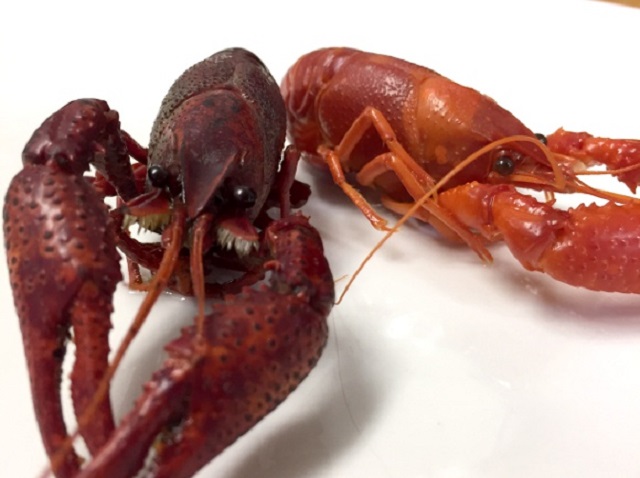
Officials have had enough of these foreign crustaceans abusing our weak border security.
Here’s a scene I’m sure we’re all familiar with: You’ve had a rough day because the boss was on your case, and when you get home that special person in your life hands you a cold and damp vinyl bag. You crack open your present and a waft of mud and algae hits your nose, making your eyes well up, but it’s not because of the stench. It’s because you’ve just received the wonderful gift of live crawdads.
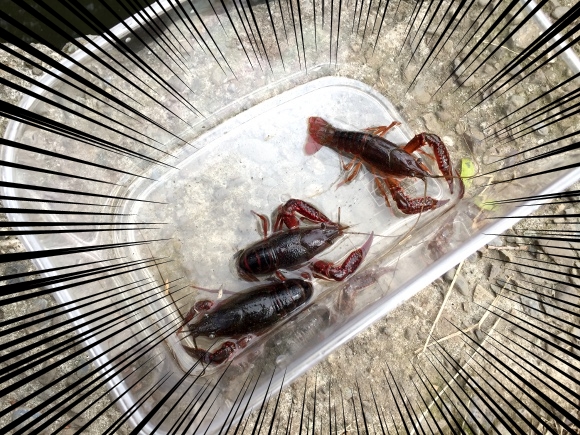
However, this idyllic scene of everyday life in Japan – and probably the whole world, I’m assuming – is now threatened by alien crayfish that bring with them potential viruses and dietary habits that could wreak havoc within Japan. In response, the Ministry of the Environment announced that they will be cracking down on these alien species starting November of this year, and anyone caught keeping or breeding the blacklisted lobster wannabes can face up to one year in prison or a million-yen (US$9,400) fine.
Luckily, the ministry outlined which crayfish are okay to interact with and which ones will land your butt in the slammer, so listen up! All members of the Cambaridae family are off limits except for Procambarus clarkii, also known as the “Louisiana crawfish,” or more affectionately as the “mudbug.” In other words, a Procambarus clarkii is all good, whereas a Procambarus fitzatricki should be reported to the authorities at all costs.
▼ Good crayfish…
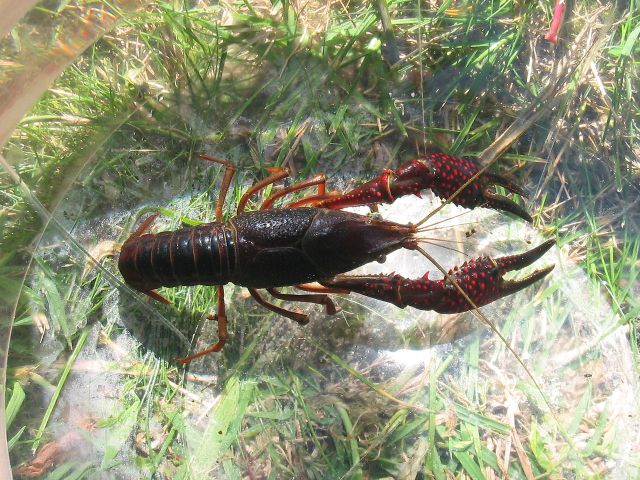
▼ …and bad crayfish, got it?
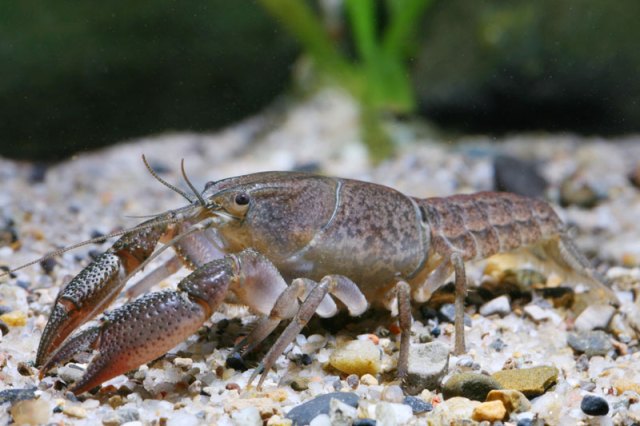
Meanwhile, the Cambaroides japonicus or “Japanese crayfish” is also a permitted species of crawdad, but should not be confused with the Cambaroides dauricus, under threat of strict penalties.
▼ Having good times with this guy…
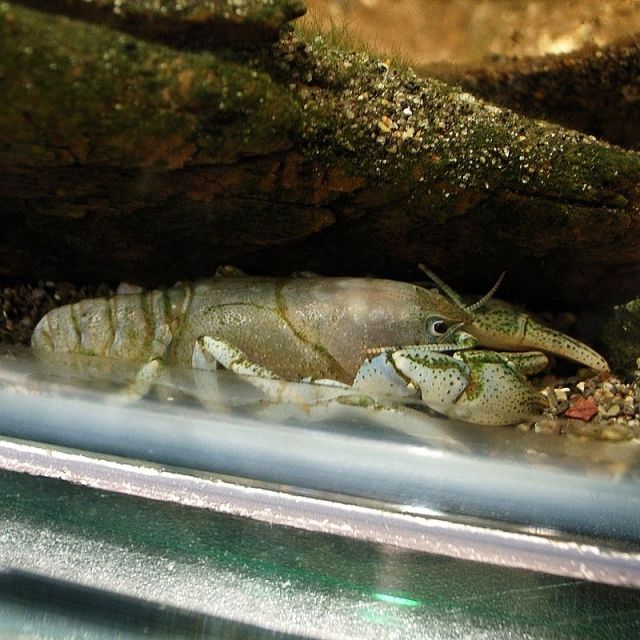
▼ Or facing hard time with this guy. You decide.
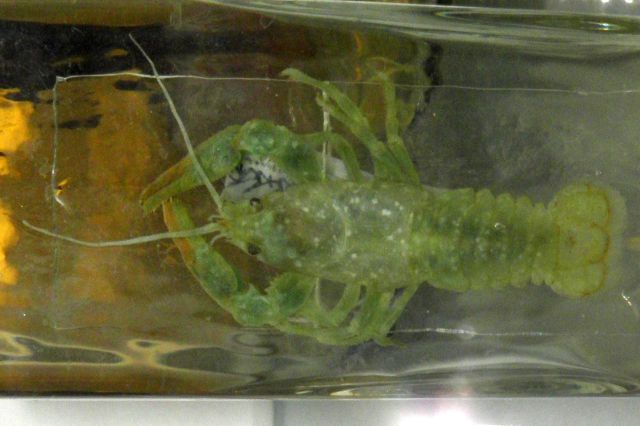
I hope you were taking notes because the ministry said that they will not accept “I didn’t know” as a valid excuse. However, in order to, prevent such incidents from happening they also issued this handy way to distinguish a Louisiana crawfish from a mystery crayfish (Procambarus virginalis).
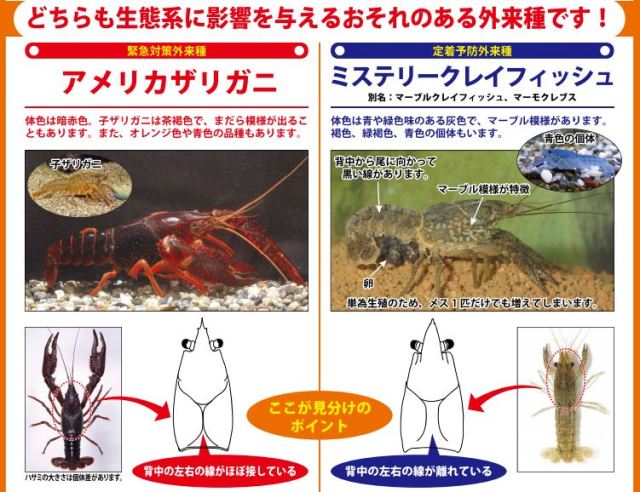
The infographic explains that the two folds of the carapace on of a mudbug touch, creating a line running back from the cephalic groove. However a mystery crayfish’s carapace has more of a gap between the folds. You can remember with this handy mnemonic I made:
If its carapace touches, then the police can’t touch us, but if the cephalic groove leads to a wide space, when the cops come knockin’ you’ll have egg on your face.
And if that doesn’t help, they’re also completely different colors.
Armed with that knowledge, you ought to be able to figure out the other 500 or so species by yourself no problem. So, let’s all practice safe crayfish gifting and raising within the terms of the law, because while a lot of this is a laughing matter, the hazardous effects invasive species can have on ecosystems and our food supply, is certainly not.
Source: Ministry of Environment, Hachima Kiko
Top image ©SoraNews24
● Want to hear about SoraNews24’s latest articles as soon as they’re published? Follow us on Facebook and Twitter!

 We eat the best crayfish of our life at a Tokyo specialty restaurant【Taste test】
We eat the best crayfish of our life at a Tokyo specialty restaurant【Taste test】 Fishin’ for crawdads in Tokyo: A tale of friendship
Fishin’ for crawdads in Tokyo: A tale of friendship Crayfish claw mistakenly eaten whole becomes huge pain in the ass
Crayfish claw mistakenly eaten whole becomes huge pain in the ass Three centipede and cockroach species are newly named and placed under protection in Okinawa
Three centipede and cockroach species are newly named and placed under protection in Okinawa Job Buddhas and paper hand jobs: Thai government’s list of jobs foreigners may not do is amazing
Job Buddhas and paper hand jobs: Thai government’s list of jobs foreigners may not do is amazing Foreigner’s request for help in Tokyo makes us sad for the state of society
Foreigner’s request for help in Tokyo makes us sad for the state of society Japanese city loses residents’ personal data, which was on paper being transported on a windy day
Japanese city loses residents’ personal data, which was on paper being transported on a windy day Akihabara pop-up shop sells goods made by Japanese prison inmates
Akihabara pop-up shop sells goods made by Japanese prison inmates Ghibli Park now selling “Grilled Frogs” from food cart in Valley of Witches
Ghibli Park now selling “Grilled Frogs” from food cart in Valley of Witches Historical figures get manga makeovers from artists of Spy x Family, My Hero Academia and more
Historical figures get manga makeovers from artists of Spy x Family, My Hero Academia and more Tokyo Tsukiji fish market site to be redeveloped with 50,000-seat stadium, hotel, shopping center
Tokyo Tsukiji fish market site to be redeveloped with 50,000-seat stadium, hotel, shopping center Beautiful Ghibli sealing wax kits let you create accessories and elegant letter decorations【Pics】
Beautiful Ghibli sealing wax kits let you create accessories and elegant letter decorations【Pics】 Harajuku Station’s beautiful old wooden building is set to return, with a new complex around it
Harajuku Station’s beautiful old wooden building is set to return, with a new complex around it Anime girl English teacher Ellen-sensei becomes VTuber/VVTUber and NFT
Anime girl English teacher Ellen-sensei becomes VTuber/VVTUber and NFT We tried Korea’s way-too-big King Tonkatsu Burger at Lotteria 【Taste Test】
We tried Korea’s way-too-big King Tonkatsu Burger at Lotteria 【Taste Test】 McDonald’s new Happy Meals offer up cute and practical Sanrio lifestyle goods
McDonald’s new Happy Meals offer up cute and practical Sanrio lifestyle goods Japanese ramen restaurants under pressure from new yen banknotes
Japanese ramen restaurants under pressure from new yen banknotes French Fries Bread in Tokyo’s Shibuya becomes a hit on social media
French Fries Bread in Tokyo’s Shibuya becomes a hit on social media Studio Ghibli releases new action figures featuring Nausicaä of the Valley of the Wind characters
Studio Ghibli releases new action figures featuring Nausicaä of the Valley of the Wind characters New private rooms on Tokaido Shinkansen change the way we travel from Tokyo to Kyoto
New private rooms on Tokaido Shinkansen change the way we travel from Tokyo to Kyoto Red light district sushi restaurant in Tokyo shows us just how wrong we were about it
Red light district sushi restaurant in Tokyo shows us just how wrong we were about it All-you-can-drink Starbucks and amazing views part of Tokyo’s new 170 meter-high sky lounge
All-you-can-drink Starbucks and amazing views part of Tokyo’s new 170 meter-high sky lounge Studio Ghibli releases Kiki’s Delivery Service chocolate cake pouches in Japan
Studio Ghibli releases Kiki’s Delivery Service chocolate cake pouches in Japan New definition of “Japanese whiskey” goes into effect to prevent fakes from fooling overseas buyers
New definition of “Japanese whiskey” goes into effect to prevent fakes from fooling overseas buyers Our Japanese reporter visits Costco in the U.S., finds super American and very Japanese things
Our Japanese reporter visits Costco in the U.S., finds super American and very Japanese things Studio Ghibli unveils Mother’s Day gift set that captures the love in My Neighbour Totoro
Studio Ghibli unveils Mother’s Day gift set that captures the love in My Neighbour Totoro More foreign tourists than ever before in history visited Japan last month
More foreign tourists than ever before in history visited Japan last month New Pokémon cakes let you eat your way through Pikachu and all the Eevee evolutions
New Pokémon cakes let you eat your way through Pikachu and all the Eevee evolutions Sales of Japan’s most convenient train ticket/shopping payment cards suspended indefinitely
Sales of Japan’s most convenient train ticket/shopping payment cards suspended indefinitely Sold-out Studio Ghibli desktop humidifiers are back so Totoro can help you through the dry season
Sold-out Studio Ghibli desktop humidifiers are back so Totoro can help you through the dry season Japanese government to make first change to romanization spelling rules since the 1950s
Japanese government to make first change to romanization spelling rules since the 1950s Ghibli founders Toshio Suzuki and Hayao Miyazaki contribute to Japanese whisky Totoro label design
Ghibli founders Toshio Suzuki and Hayao Miyazaki contribute to Japanese whisky Totoro label design Doraemon found buried at sea as scene from 1993 anime becomes real life【Photos】
Doraemon found buried at sea as scene from 1993 anime becomes real life【Photos】 Tokyo’s most famous Starbucks is closed
Tokyo’s most famous Starbucks is closed One Piece characters’ nationalities revealed, but fans have mixed opinions
One Piece characters’ nationalities revealed, but fans have mixed opinions We asked a Uniqlo employee what four things we should buy and their suggestions didn’t disappoint
We asked a Uniqlo employee what four things we should buy and their suggestions didn’t disappoint Princesses, fruits, and blacksmiths: Study reveals the 30 most unusual family names in Japan
Princesses, fruits, and blacksmiths: Study reveals the 30 most unusual family names in Japan Ghibli toy creature cars — Nausicaa’s Ohmu’s have become creepily cute pull-back toys【Video】
Ghibli toy creature cars — Nausicaa’s Ohmu’s have become creepily cute pull-back toys【Video】 You might never eat seafood again after you watch this horrifying lobster molting on land
You might never eat seafood again after you watch this horrifying lobster molting on land Japanese TV show about draining ponds becomes surprise hit with viewers
Japanese TV show about draining ponds becomes surprise hit with viewers Cup Noodle releases new Rare Species Mystery Meat flavor, and we brave it with a taste test
Cup Noodle releases new Rare Species Mystery Meat flavor, and we brave it with a taste test Japanese ministry finds correlation between level of income and diet, number of teeth
Japanese ministry finds correlation between level of income and diet, number of teeth Something’s not quite right with the neighbor’s plants… Mario’s enemies sprouting up in Japan
Something’s not quite right with the neighbor’s plants… Mario’s enemies sprouting up in Japan Strange bird outside Shinjuku Station looks like a reincarnated salaryman
Strange bird outside Shinjuku Station looks like a reincarnated salaryman Poisonous spider found at venue of Tokyo’s biggest anime convention one week before it kicks off
Poisonous spider found at venue of Tokyo’s biggest anime convention one week before it kicks off Eevee cafes and Pokémon therapy: Artists imagine “living with Pokémon” pets【Illustrations】
Eevee cafes and Pokémon therapy: Artists imagine “living with Pokémon” pets【Illustrations】 Bug hunt! Some areas offering rewards for alien beetles threatening Japan’s cherry blossoms
Bug hunt! Some areas offering rewards for alien beetles threatening Japan’s cherry blossoms Wasabi found to promote hair growth 3 times faster than minoxidil
Wasabi found to promote hair growth 3 times faster than minoxidil Tokyo’s new pre-fixed taxi fare smartphone service reduces the guess work of travelling by cab
Tokyo’s new pre-fixed taxi fare smartphone service reduces the guess work of travelling by cab Japan officially declared coronavirus-infected nation by Micronesia, travel restrictions enacted
Japan officially declared coronavirus-infected nation by Micronesia, travel restrictions enacted Vinyl flower vases are all the rage right now in Japan
Vinyl flower vases are all the rage right now in Japan Ridesharing services legalized for Tokyo and Kyoto, but does this change anything?
Ridesharing services legalized for Tokyo and Kyoto, but does this change anything? First new Japanese cockroach species in 35 years discovered by scientists【Photos】
First new Japanese cockroach species in 35 years discovered by scientists【Photos】 Get huge discounts on Japanese hotels… provided you’re a space alien (or claim to be one)
Get huge discounts on Japanese hotels… provided you’re a space alien (or claim to be one)
Leave a Reply